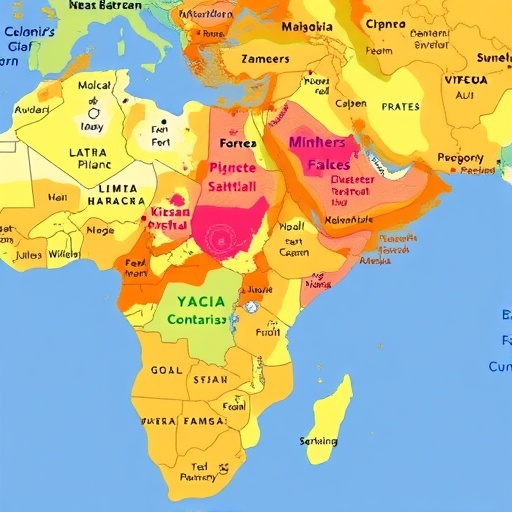In the realm of environmental and social sustainability, mining remains one of the most contentious industries, often pitting economic development against ecological preservation. A groundbreaking study by K. Svobodova and J.A. Everingham introduces a novel approach to mining planning and closure, integrating Participatory Geographic Information Systems (PPGIS) into the social impact assessment processes. This initiative offers a comprehensive framework that not only emphasizes community involvement but also enhances decision-making strategies, aiming to mitigate the adverse effects of mining operations on local populations and the environment.
PPGIS represents a significant shift in traditional planning methodologies, enabling stakeholders to visualize data relevant to their communities. In mining contexts, this technology harnesses geospatial tools that allow community members to voice their concerns and aspirations, generating a more inclusive dialogue between mining companies, policymakers, and local residents. The implications are vast, suggesting that when communities can map out their priorities and concerns, the likelihood of tensions arising from mining operations decreases significantly.
Integral to this approach is the understanding that social impact assessments often lack robust community input. Classic methodologies fall short in capturing the nuanced perspectives of local residents who bear the brunt of mining activity. By incorporating PPGIS, Svobodova and Everingham propose a solution that not only empowers local communities to engage actively but also provides mining companies with a clearer understanding of the socio-environmental landscape in which they operate.
One key aspect highlighted in the study is the importance of transparency. Often, mining companies operate in environments where distrust is prevalent, stemming from historical exploitation and inadequate consultation processes. The integration of PPGIS allows for a more transparent relationship between stakeholders, fostering trust that can lead to more equitable outcomes. As companies become more attuned to community-generated data, they can better address concerns related to environmental degradation, displacement, and other forms of social disruption.
The ability of communities to visualize their own geographies also plays a critical role in this framework. When residents utilize PPGIS tools, they can pinpoint areas of cultural significance, resource availability, and critical environmental zones. This level of granularity in data collection is invaluable; it ensures that assessments are informed by local knowledge, which is often overlooked in conventional models. The study illustrates this by presenting case studies where community mapping has significantly altered planning decisions, leading to more sustainable outcomes.
Moreover, engaging local populations via PPGIS can have profound implications for mines in terms of regulatory compliance. By aligning company objectives with community priorities, firms can anticipate and address potential regulatory challenges rather than facing backlash post-implementation. This proactive approach not only streamlines the permitting process but also promotes corporate social responsibility, an increasingly crucial factor for investors and consumers alike.
Svobodova and Everingham’s research also delves into the comparative merits of utilizing PPGIS versus traditional impact assessment approaches. They found that PPGIS offers a more dynamic and continuously updated representation of community needs and environmental challenges. Unlike static assessments that might be conducted once every few years, PPGIS facilitates an ongoing dialogue, allowing for real-time data collection and response mechanisms.
In an age where stakeholder engagement is paramount, the findings suggest that PPGIS can serve as a powerful tool in increasing public participation in the mining sector. The increasing availability of technology and mobile devices means that communities can access and contribute data more easily than ever before. This democratization of information is revolutionary, equipping grassroots movements with tools to challenge decisions that adversely affect their lives and environments.
The implications of this research extend beyond mere planning methodologies; they provoke a re-evaluation of how mining operations are integrated into community fabric. By advocating for community-oriented strategies, mining companies can transition from extractive practices to more inclusive operations that factor in local needs and sustainability. This shift can redefine corporate values, aligning profitability with social conscience.
As the world grapples with the dual crises of climate change and biodiversity loss, leveraging tools like PPGIS becomes imperative. Svobodova and Everingham argue that adapting these technologies in mining could be a prototype for similar ventures across other industries, heralding a new era of participatory governance. This approach could create pathways for minimizing impacts not only in mining but across various sectors that disrupt local ecosystems.
The broader implications of integrating PPGIS into social impact assessments are manifold, suggesting that this strategy could catalyze systemic change within the mining industry. It calls into question the prevalent top-down decision-making paradigms that have historically governed resource extraction. As more studies corroborate the effectiveness of such participatory methods, the mining industry may find itself at a crucial crossroads, where the adoption of PPGIS becomes not just beneficial but essential.
Ultimately, the study by Svobodova and Everingham illustrates a paradigm shift in how we consider the intersections of mining, community, and environment. It highlights the potential of participatory mapping to bridge gaps between stakeholders, thus fostering a collaborative spirit instead of an adversarial one. With this dynamic framework, future mining projects could significantly reduce the environmental footprint while enhancing the quality of life for many communities.
In conclusion, as the mining sector looks toward sustainable practices within an increasingly environmentally conscious world, the integration of PPGIS into social impact assessments may well represent a crucial step forward. Stakeholders must take note of the necessity of involving local communities as equal partners in decision-making processes. Only then can the industry truly begin to redefine its impact and contribute positively to the ecosystems and communities it affects.
Subject of Research: Integration of Participatory Geographic Information Systems (PPGIS) into social impact assessments for mining operations.
Article Title: Mapping what matters: Integrating PPGIS into social impact assessment for mine planning and closure.
Article References:
Svobodova, K., Everingham, JA. Mapping what matters: Integrating PPGIS into social impact assessment for mine planning and closure.
Ambio (2025). https://doi.org/10.1007/s13280-025-02252-3
Image Credits: AI Generated
DOI:
Keywords: Participatory Geographic Information Systems, social impact assessment, mining, community involvement, environmental sustainability.




